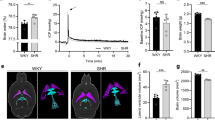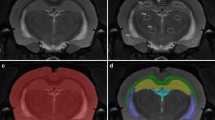Summary
Brain edema associated with severe chronic hypertension was studied in stroke-prone spontaneously neously hypertensive rats (SHRSP), 5 to 9 months of age. Blood-brain barrier (BBB) leakage sites and intracerebral spreading pathways for plasma proteins were delineated by an intravenously (i.v.) injected exogenous dye tracer (Evans blue), known to form a complex with albumin in blood, and by immunohistochemical visualization of extravasated endogenous plasma proteins. The tissue content of edema fluid was estimated by measuring the specific gravity of selected brain regions, stained or unstained by the tracer dye, on a bromobenzene-kerosene gradient column. Multifocal BBB leakage sites were macroscopically detected within the cerebral cortex and the deep gray matter after i. v. circulation of Evans blue-albumin for 30 min. After 24 h of i.v. circulation the dye tracer had spread not only locally in the gray matter but also into the adjacent white matter, where it was widely distributed. Immunohistochemically visualized plasma proteins showed similar distribution. Unilateral superior cervical ganglionectomy performed at 4 weeks of age neither increased the incidence of major BBB opening to Evans blue-albumin nor altered the specific gravity of the ipsilateral cerebral hemisphere in grown-up SHRSP, furthermore, the blood pressure remained unchanged. The lack of significant effect on BBB function may possibly be attributed to the extensive reinnervation of the cerebral arteries, verified in the grown-up SHRSP using the Falck-Hillarp fluorescence method for visualization catecholaminergic nerve fibers. In SHRSP raised on a low-protein and high-salt diet the mean arterial blood pressure was 212 mm Hg compared to 195 mm Hg in controls (P<0.05) and the incidence of BBB opening was 72% compared to 25% in controls (P<0.05). After 24 h of i.v. circulation of Evans blue-albumin, brain regions stained by the dye tracer showed significantly reduced specific gravity (P<0.001), while unstained regions had normal values. Thus the brain edema fluid spread, as revealed by specific gravity measurements, corresponded to the intracerebral distribution of extravasated plasma proteins.
Similar content being viewed by others
References
Barsanti JA, Pillsbury HRC III, Freis ED (1971) Enhanced salt toxicity in the spontaneously hypertensive rat. Proc Soc Exp Biol 136:565–568
Bevan RD (1984) Trophic effects of peripheral adrenergic nerves on vascular structure. Hypertension 6 [Suppl 111]: 19–26
Bevan RD, Tsuru H, Bevan JA (1983) Cerebral artery mass in the rabbit is reduced by chronic sympathetic denervation. Stroke 14:393–396
Björklund A, Falck B, Owman C (1972) Fluorescence microscopic and microspectrofluorometric techniques for cellular localization and characterization of biogenic amines. In: Rall JE, Kopin IJ (eds) Methods of investigative and diagnostic endocrinology, vol 1. North-Holland, Amsterdam, pp 318–368
Bothe HW, Bodsch W, Hossmann KA (1984) Relationship between specific gravity, water content and serum protein extravasation in various types of vasogenic brain edema. Acta Neuropathol (Berl) 64:37–42
Byrom FB (1954) The pathogenesis of hypertensive encephalopathy and its relation to the malignant phase of hypertension. Lancet II:201–211
Chrysant SG, Walsh GM, Kem DC, Frolich ED (1979) Hemodynamic and metabolic evidence of salt sensitivity in spontaneously hypertensive rats. Kidney Int 15:33–37
Ferszt R, Hamn H, Cervo's-Navarro J (1980) Measurement of the specific gravity of the brain as a tool in brain edema research. Adv Neurol 28:15–26
Fredriksson K, Auer RN, Kalimo H, Nordborg C, Olsson Y, Johansson BB (1985) Cerebrovascular lesions in strokeprone spontaneously hypertensive rats. Acta Neuropathol (Berl) 68:284–294
Fujiwara K, Nitsch C, Suzuki R, Klatzo I (1981) Factors in the reproducibility of the gravimetric method for evaluation of edematous changes in the brain. Neurol Res 3:345–361
Gradin K, Dahlöf C, Persson B (1986) A low dietary sodium intake reduces noradrenaline release and the blood pressure in spontaneously hypertensive rats. Naunyn-Schmiedeberg's Arch Pharmacol 332:364–369
Hart MN, Heistad DD, Brody MJ (1980) Effect of chronic hypertension and sympathetic denervation on wall/lumen ratio of cerebral vessels. Hypertension 2:419–423
Hazama F, Ooshima A, Tanaka T, Tomimoto K, Okamoto K (1975) Vascular lesions in the various substrains of spontaneously hypertensive rats and the effect of chronic salt ingestion. Jpn Circ J 39:7–21
Johansson BB, Auer LM, Hodde KC, Nordborg C (1985) Cerebral resistance vessel morphometry in normotensive and hypertensive rats. Prog Appl Microcirc 8:111–121
Klatzo I, Chui E, Fujiwara K, Spatz M (1980) Resolution of brain edema. Adv Neurol 28:359–373
Kuroiwa T, Cahn R, Juhler M, Goping G, Campbell G, Klatzo I (1985) Role of extracellular proteins in the dynamics of vasogenic brain edema. Acta Neuropathol (Berl) 66:3–11
Kåhrström J, Hardebo JE, Nordborg C, Owman C (1986) Experiments on cerebrovascular nerve plasticity and trophic vascular adaptation in young and adult rats. In: Owman C, Hardebo JE (eds) Neural regulation of brain circulation Fernström Foundation Series, vol 8. Elsevier, Amsterdam, pp 589–606
Limas C, Westrum B, Limas CJ, Cohn JN (1980) Effect of salt on the vascular lesions of spontaneously hypertensive rats. Hypertension 2:477–489
Nelson SR, Mantz M-L, Maxwell JA (1971) Use of specific gravity in the measurement of cerebral edema. J Appl Physiol 30:268–271
Ogata J, Fujishima M, Tamaki K, Nakatomi Y, Ishitsuka T, Omae T (1980) Stroke-prone spontaneously hypertensive rats as an experimental model of malignant hypertension. Acta Neuropathol (Berl) 51:179–184
Ogata J, Fujishima M, Tamaki K, Nakatomi Y, Ishitsuka T, Omae T (1981) Vascular changes underlying cerebral lesions in stroke-prone spontaneously hypertensive rats. Acta Neuropathol (Berl) 54:183–188
Okamoto K, Yamori Y, Nagaoka A (1974) Establishment of the stroke-prone spontaneously hypertensive rat (SHR). Cire Res 34, 35 [Suppl I]:143-153
Sadoshima S, Heistad D (1982) Sympathetic nerves protect the blood-brain barrier in stroke-prone spontaneously hypertensive rats. Hypertension 4:904–907
Sadoshima S, Busija D, Brody M, Heistad D (1981) Sympathetic nerves protect against stroke in stroke-prone spontaneously hypertensive rats. Hypertension 3 [Suppl I]: 124–127
Sadoshima S, Busija DW, Heistad DD (1983) Mechanisms of protection against stroke in stroke-prone spontaneously hypertensive rats. Am J Physiol 244:H406-H412
Tamaki K, Sadoshima S, Baumbach GL, Iadecola C, Reis DJ, Heistad DD (1984) Evidence that disruption of the blood-brain barrier precedes reduction in cerebral blood flow in hypertensive encephalopathy. Hypertension 6 [Suppl I]:75–81
Werber AH, Baumbach GL, Wagner DV, Mark Al, Heistad DD (1985) Factors that influence stroke in Dahl salt-sensitive rats. Hypertension 7:59–64
Wexler BC (1983) Low-protein fish vs. low-protein animal diet enhances the propensity for stroke in stroke-prone/SHR. Stroke 14:585–590
Wolman M, Klatzo I, Chui E, Wilmes F, Nishimoto K, Fujiwara K, Spatz M (1981) Evaluation of the dye-protein tracers in pathophysiology of the blood-brain barrier. Acta Neuropathol (Berl) 54:55–61
Yamori Y, Horie R, Ikeda K, Nara Y, Lovenburg W (1979) Prophylactic effect of dietary protein on stroke and its mechanisms. In: Yamori Y, Lovenberg W, Freis ED (eds) Prophylactic approach to hypertensive diseases. Raven Press, New York, pp 497–504
Yamori Y, Horie R, Nara Y, Kihara M, Tada M (1981) Studies on stroke prevention in animal models and their supportable epidemiological evidence. In: Barnett H, Paoletti P, Flamm E, Brambilla G (eds) Cerebrovascular diseases. New trends in surgical and medical aspects. Elsevier/North-Holland Biomedical Press, Amsterdam, pp 47–62
Yamori Y, Horie R, Tanase H, Fujiwara K, Nara Y, Lowenburg W (1984) Possible role of nutritional factors in the incidence of cerebral lesions in stroke-prone spontaneously hypertensive rats. Hypertension 6:49–53
Author information
Authors and Affiliations
Additional information
Supported by The Swedish Medical Research Council (Project 12P-6827, 12X-07123, 14X-4968, 14X-732), The Swedish National Association Against Heart and Chest Diseases, The Medical Faculty, University of Lund, The MS-fund, Elsa Schmitz' Fund for Neurological and Neurosurgical Research, Rut and Erik Hardebo's Foundation, Fredrik and Ingrid Thuring's Foundation
Rights and permissions
About this article
Cite this article
Fredriksson, K., Kalimo, H., Westergren, I. et al. Blood-brain barrier leakage and brain edema in stroke-prone spontaneously hypertensive rats. Acta Neuropathol 74, 259–268 (1987). https://doi.org/10.1007/BF00688190
Received:
Accepted:
Issue Date:
DOI: https://doi.org/10.1007/BF00688190




